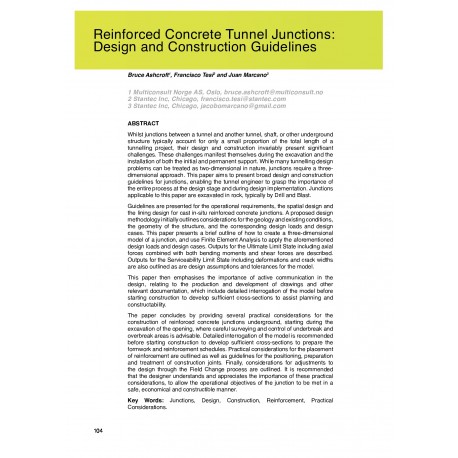Cart
0
0
No document
0,00 €
Total
Document successfully added to your shopping cart
Quantity
Total
There are 0 items in your cart.
There is 1 item in your cart.
Total documents
Total shipping
To be determined
Total
Search & filter
Search for a publication
Search & filter
Reinforced Concrete Tunnel Junctions: Design and Construction Guidelines
834_reinforced_concrete_tunnel_j
B. Ashcroft / F. Tesi / J. Marcano
Whilst junctions between a tunnel and another tunnel, shaft, or other underground structure typically account for only a small proportion of the total length of a tunnelling project, their design and construction invariably present significant challenges. These challenges manifest themselves during the excavation and the installation of both the initial and permanent support. While many tunnelling design problems can be treated as two-dimensional in nature, junctions require a threedimensional approach. This paper aims to present broad design and construction guidelines for junctions, enabling the tunnel engineer to grasp the importance of the entire process at the design stage and during design implementation. Junctions applicable to this paper are excavated in rock, typically by Drill and Blast.Guidelines are presented for the operational requirements, the spatial design and the lining design for cast in-situ reinforced concrete junctions. A proposed design methodology initially outlines considerations for the geology and existing conditions, the geometry of the structure, and the corresponding design loads and design cases. This paper presents a brief outline of how to create a three-dimensional model of a junction, and use Finite Element Analysis to apply the aforementioned design loads and design cases. Outputs for the Ultimate Limit State including axial forces combined with both bending moments and shear forces are described. Outputs for the Serviceability Limit State including deformations and crack widths are also outlined as are design assumptions and tolerances for the model.This paper then emphasises the importance of active communication in the design, relating to the production and development of drawings and other relevant documentation, which include detailed interrogation of the model before starting construction to develop sufficient cross-sections to assist planning and constructability.The paper concludes by providing several practical considerations for the construction of reinforced concrete junctions underground, starting during the excavation of the opening, where careful surveying and control of underbreak and overbreak areas is advisable. Detailed interrogation of the model is recommended before starting construction to develop sufficient cross-sections to prepare the formwork and reinforcement schedules. Practical considerations for the placement of reinforcement are outlined as well as guidelines for the positioning, preparation and treatment of construction joints. Finally, considerations for adjustments to the design through the Field Change process are outlined. It is recommended that the designer understands and appreciates the importance of these practical considerations, to allow the operational objectives of the junction to be met in a safe, economical and constructible manner.Junctions, Design, Construction, Reinforcement, Practical Considerations.




